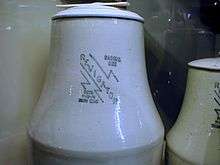Radium ore Revigator
The radium ore Revigator was a pseudoscientific medical device consisting of a ceramic water crock lined with radioactive materials. It was patented in 1912 by R. W. Thomas.[1] Thomas was working at the time as a stock salesman in Arizona[2] but, by 1923, had moved to southern California to begin manufacture of his patent. In 1924, following several successful advertisement campaigns that left him unable to keep up with demand, he sold his operation to Dow-Herriman Pump & Machinery Company, selling thousands of the devices in the 1920s and 1930s.[3]

The Revigator was intended to be filled with water overnight, which would be irradiated by the uranium and radium in the liner, and then consumed the next day. This was marketed as a healthy practice which could prevent illnesses including arthritis, flatulence, and senility.
The Revigator contained carnotite K2(UO2)2(VO4)2·3H2O. Water stored overnight in a vintage Revigator was analyzed by ICP-MS and radiation detectors. Although the water contained higher levels of radon, the health risk from radiation was low. Even so, the water contained detectable levels of arsenic, lead, vanadium, and uranium.[4]
See also
References
- Ross Mullner. Deadly glow: the radium dial worker tragedy. American Public Health Association, 1999. Original from the University of Michigan ISBN 0-87553-245-4
- "The Historical Collection: The Revigorator".
- Ritter, S. (2010). "Really Hot Drink, Centenarian Canines". Chemical & Engineering News. 88 (18): 56. doi:10.1021/cen-v088n018.p056.
- Epstein, M.S.; et al. (2009). "What Were They Drinking? A Critical Study of the Radium Ore Revigator". Applied Spectroscopy. 63 (1406): 1406–1409. doi:10.1366/000370209790109003.
US 1032951 Radio-active Material